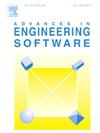通过改进的梁单元模型考虑筋横向布置的箱梁剪力滞后和剪力变形
IF 4
2区 工程技术
Q2 COMPUTER SCIENCE, INTERDISCIPLINARY APPLICATIONS
引用次数: 0
摘要
预应力混凝土(PC)箱梁中的筋的横向和纵向布置会产生复杂的力学行为,需要对其进行精确评估,以便进行有效的结构设计。然而,现有的研究往往忽略了筋横向布置的影响。为了弥补这一缺陷,我们开发了一种改进的梁元素(命名为 B12TS),用于分析预应力效应下 PC 箱梁的剪切变形和剪切滞后。该元素通过将筋的非均匀纵向位移建模为一系列片断线性段,从而整合了筋的横向布局。预应力被转换为作用在元素上的等效节点力。元件形状函数由相关微分方程的均质解导出。涉及各种梁元素模型、现有实验数据和三维(3D)有限元模拟的比较分析表明,B12TS 元素模型显著提高了预测挠度和应力分布的精度和效率。此外,还研究了预应力对典型 PC 箱梁翼缘和腹板筋的影响,以量化剪力滞后、剪切变形和筋横向布置的影响。研究结果表明,翼缘筋的横向布置对法向应力的大小和分布形状都有显著影响,尤其是在锚固位置附近。因此,B12TS 元素模型被证明是设计具有各种肌腱布局的棱柱式和非棱柱式 PC 箱梁桥的重要分析工具。本文章由计算机程序翻译,如有差异,请以英文原文为准。
Shear lag and shear deformation in box girders considering tendon transverse layout by improved beam element model
The transverse and vertical layouts of tendons within prestressed concrete (PC) box girders induce complex mechanical behaviors that necessitate precise evaluation for effective structural design. However, existing investigations often overlook the impact of tendon transverse layout. To address this gap, an improved beam element, designated as B12TS, is developed for shear deformation and shear lag analyses of PC box girders under prestressing effects. The element integrates the tendon transverse layout through non-uniform longitudinal displacements of the tendons modeled as a series of piecewise linear segments. The prestressing forces are converted into equivalent nodal forces acting on the elements. The element shape functions are derived from the homogeneous solutions to the relevant differential equations. Comparative analyses involving various beam element models, available experimental data, and three-dimensional (3D) finite element simulations demonstrate that the B12TS element model significantly enhances the accuracy and efficiency of predicting both deflections and stress distributions. Furthermore, the effects of prestressing on the flange and web tendons of typical PC box beams are examined to quantify the impacts of shear lag, shear deformation, and tendon transverse layout. The findings reveal that the transverse layout of the flange tendons remarkably influences both the magnitude and distribution shape of normal stresses, particularly near anchorage locations. Consequently, the B12TS element model proves to be a valuable analysis tool for designing prismatic and non-prismatic PC box girder bridges with various tendon layouts.
求助全文
通过发布文献求助,成功后即可免费获取论文全文。
去求助
来源期刊

Advances in Engineering Software
工程技术-计算机:跨学科应用
CiteScore
7.70
自引率
4.20%
发文量
169
审稿时长
37 days
期刊介绍:
The objective of this journal is to communicate recent and projected advances in computer-based engineering techniques. The fields covered include mechanical, aerospace, civil and environmental engineering, with an emphasis on research and development leading to practical problem-solving.
The scope of the journal includes:
• Innovative computational strategies and numerical algorithms for large-scale engineering problems
• Analysis and simulation techniques and systems
• Model and mesh generation
• Control of the accuracy, stability and efficiency of computational process
• Exploitation of new computing environments (eg distributed hetergeneous and collaborative computing)
• Advanced visualization techniques, virtual environments and prototyping
• Applications of AI, knowledge-based systems, computational intelligence, including fuzzy logic, neural networks and evolutionary computations
• Application of object-oriented technology to engineering problems
• Intelligent human computer interfaces
• Design automation, multidisciplinary design and optimization
• CAD, CAE and integrated process and product development systems
• Quality and reliability.
 求助内容:
求助内容: 应助结果提醒方式:
应助结果提醒方式:


